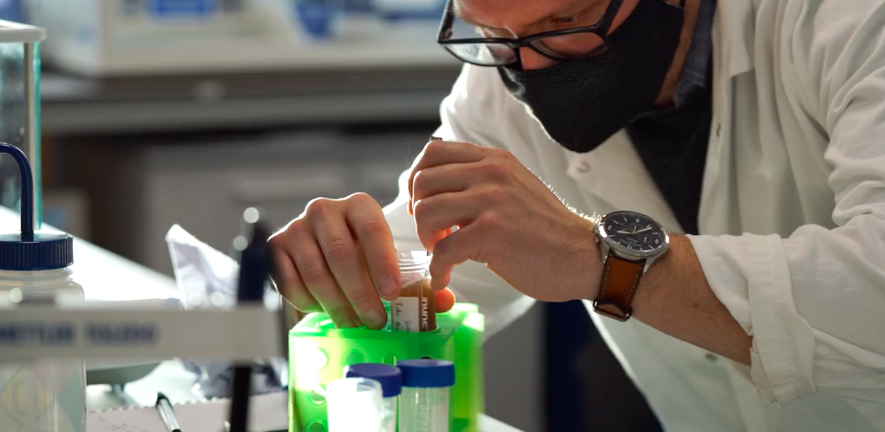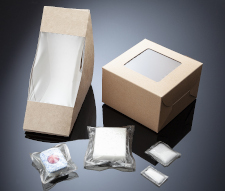
In a paper published in Nature Communications, researchers from the Knowles group describe how they can create the polymer film from plant proteins in a sustainable and scalable way.
The new material is as strong as the most common plastics in use today and could replace plastic in many common household products. It is home compostable and will degrade naturally in a marine environment and in fresh water.
To create the material, the researchers developed a new approach for assembling plant proteins into materials which mimic silk on a molecular level. The energy-efficient method, which uses sustainable ingredients, results in a plastic-like free-standing film, which can be produced at industrial scale. Non-fading 'structural' colour can be added to the polymer, and it can also be used to make water-resistant coatings.
The new product will be commercialised by Xampla, a Knowles Lab spin-out which develops replacements for single-use plastic and microplastics.
Dr Marc Rodriguez Garcia, Xampla’s Head of R&D and one of the paper’s co-authors, said: “It’s amazing to realise that a discovery you make in a lab can have a big impact on solving a global problem. That’s essentially why we are doing this – we really love the science, but we also wanted to do something meaningful about solving the overwhelming problem of plastic waste.”
Professor Tuomas Knowles, who led the research, said: “One of the key breakthroughs is that we can now control the assembly of natural plant proteins into technologically useful structures. We can also now do this in a scalable way which is critical to actually be able to start replacing plastics in real world applications.”

Products made with the sustainable, compostable plastic-substitute
Proteins behaving badly
For many years the Knowles group has been conducting basic research into the behaviour of proteins. Much of the research has been focused on what happens when proteins misfold or ‘misbehave’, and how this relates to health and human disease, primarily Alzheimer's disease.
“We normally investigate how functional protein interactions allow us to stay healthy and how irregular interactions are implicated in Alzheimer’s disease,” said Knowles. “It was a surprise to find our research could also address a big problem in sustainability: that of plastic pollution.”
Strength out of weakness
As part of their protein research, Knowles and his group became interested in why materials like spider silk could be so strong when they had such weak molecular bonds. “You’d think to obtain strong materials you’d need strong interactions between building blocks, but the building blocks of spider’s silk are based on weak, non-covalent interactions,” explained Knowles.
“We found that one of the key features that makes spider silk strong is that the non-covalent hydrogen bonds are arranged regularly in space and at a very high density,” said Knowles.
When Rodriquez Garcia joined the group as a postdoctoral researcher, he began looking at how to replicate this regular self-assembly in other proteins. Proteins have a propensity towards molecular self-organisation and self-assembly, and plant proteins in particular are abundant and can be sourced sustainably as by-products of the food industry.
Rodriguez Garcia was joined in the project by first author Ayaka Kamada, when she started her PhD in the group four years ago. “I was inspired by the potential of this idea,” said Kamada. “Very little is known about the self-assembly of plant proteins, and it’s exciting to know that by filling this knowledge gap we can find alternatives to single-use plastics.”
“We were inspired to ask: ‘Can we generate silk-like structures from building blocks that were not related to silk at all?’” said Knowles. “In principle, this should be possible, but it was not clear if it was practical -- that’s the project that Ayaka and Marc took on and have now shown in spectacular fashion that this is possible.”
A vegan spider?
The researchers have shown that they can successfully replicate the structures found on spider silk, by using a protein with a completely different composition. “Because all proteins are made of polypeptide chains, under the right conditions we can cause plant proteins to self-assemble just like spider silk,” said Knowles. “In the spider, the silk protein is dissolved in an aqueous solution, which then assembles into an immensely strong fibre through a spinning process which requires very little energy – those are all characteristics we keep. Even on a single-molecule level, the material looks like silk.”
“Other researchers have been working directly on silk materials but they remain an animal product with issues relating to sustainability. “In a way we’ve come up with a ‘vegan spider’ – we’ve created the same material without having to have the spider.”
The alchemy of protein assembly
Any replacement for plastic requires another polymer – the two in nature that exist in abundance are polysaccharides and polypeptides. Cellulose and nanocellulose are polysaccharides and have been used for a range of applications, but often require some form of cross-linking to form strong materials. Proteins self-assemble and can form strong materials like silk without any chemical modifications, but they are much harder to work with.
The researchers chose soy protein isolate (SPI) as their test plant protein, since it is readily available as a by-product of soybean oil production. Plant proteins such as SPI are poorly soluble in water, making it hard to control their self-assembly into ordered structures.
The new technique uses an environmentally friendly mixture of acetic acid and water, combined with ultrasonication and high temperatures, to improve the solubility of the SPI. This method produces protein structures with enhanced inter-molecular interactions guided by the hydrogen bond formation. In a second step the solvent is removed, which results in a water-insoluble film.
“It’s almost like alchemy -- you start with a very uninteresting-looking brown powder that is not even soluble in water. First you must disassemble it and re-assemble it in a completely different way. It’s not completely straightforward to generate this process, you must develop a fine balance between disrupting the bonding within the molecule while favouring the intermolecular interactions. If you don’t get self-assembly, it just crumbles,” said Knowles.
“But with the technique developed by Marc and Ayaka, you end up with an incredibly high-performance material, equivalent to high performance engineering plastics such as low-density polyethylene. And the self-assembly occurs not just on a molecular scale, but also on a metre scale and more.”
The material has a performance equivalent to high performance engineering plastics such as low-density polyethylene. Its strength lies in the regular arrangement of the polypeptide chains, meaning there is no need for chemical cross-linking, which is frequently used to improve the performance and resistance of biopolymer films. The most commonly used cross-linking agents are non-sustainable and can even be toxic, whereas no toxic elements are required for the Cambridge-developed technique. “None of that’s required here,” said Knowles.
“This is the culmination of something we’ve been working on for over ten years, which is understanding how nature generates materials from proteins. We didn’t set out to solve a sustainability challenge -- we were motivated by curiosity as to how to create strong materials from weak interactions.”
Next steps
Kamada recently submitted her PhD thesis, and has been awarded a prestigious two-year Marie Curie Industrial Fellowship, which will allow her to continue her research for both Xampla and the Knowles group.
As Xampla’s Head of Research, Rodriguez Garcia is leading the technical development work.The company already produces biodegradable microcapsules. “Microcapsules are microscale containers too small to see by the naked eye, which are ubiquitous in everyday products like shampoo and detergents, and are currently made out of different types of synthetic polymers. Once in the environment there’s just no way of getting rid of them. Every part of the planet now is contaminated with microplastics,” said Rodriguez Garcia.
Xampla will also be introducing a range of single-use sachets and capsules later this year, which can replace the plastic used in everyday products like dishwasher tablets and laundry detergent. “We are developing new products all the time,” said Rodriguez Garcia. “The key breakthrough here is being able to control self-assembly, so we can now create high performance materials. There’s always a gap from discovering something in the lab to making a product, but there’s a lot of excitement about taking this type of technology that Ayaka has pioneered and industrialising it.
“It’s exciting to be part of this journey, to be exposed to the science, the manufacturing and the commercial side. There is a huge, huge issue of plastic pollution in the world. We all feel a responsibility to do this, and get people to use these materials.”
Research
A. Kamada, M. Rodriguez-Garcia, F. Simone Ruggeri, Y. Shen, A. Levin and T.P.J. Knowles, Controlled self-assembly of plant proteins into high-performance multifunctional nanostructured films.
With grateful thanks to Sarah Collins for her contributions to this article.

